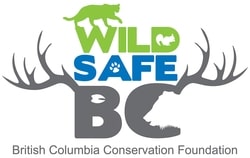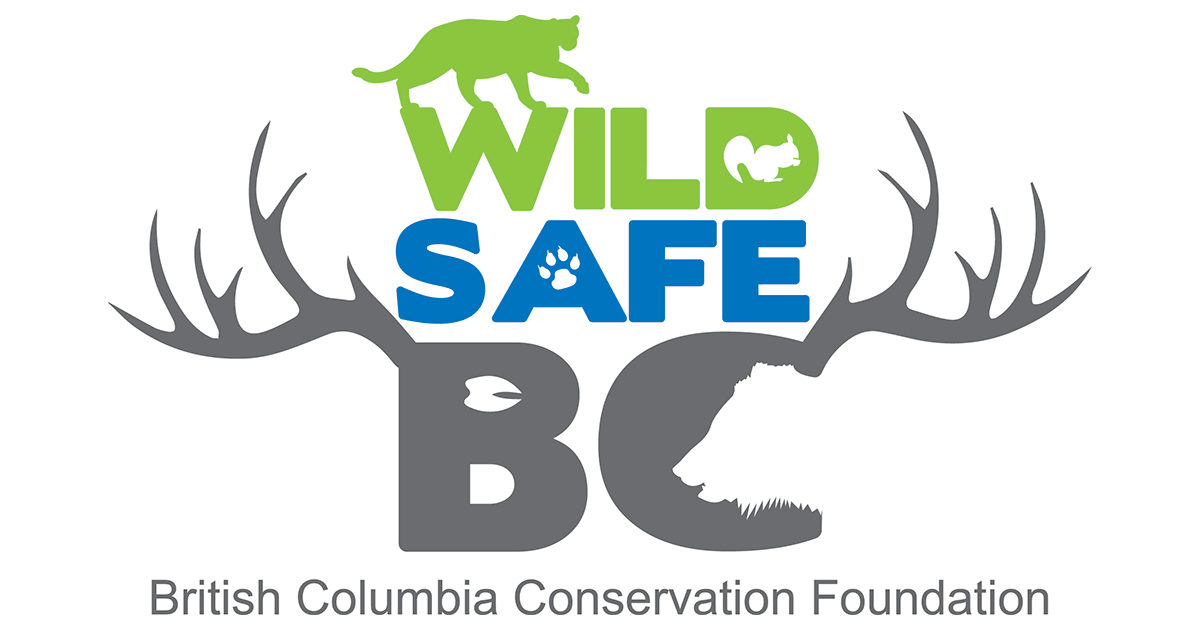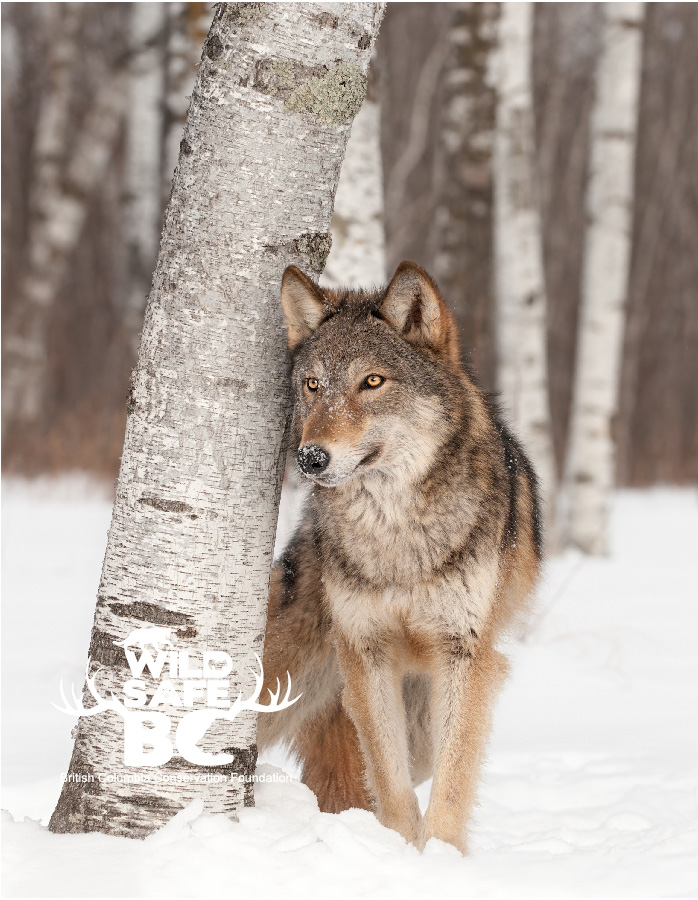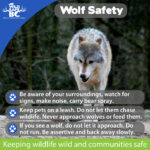Wolf
Wolf Snapshot
The grey wolf (Canis lupus) is the largest of the North American canines which includes coyotes, foxes and domestic dogs. It is estimated that there are approximately 8,500 wolves in BC but this number can vary substantially year to year. Wolves are social animals closely related to coyotes and domestic dogs but with noticeable differences. Wolves are larger than coyotes with wide broad paws, a broader snout and rounded ear tips. While running, wolves tend to carry their tails out behind them unlike coyotes that will carry their tails downwards. Despite its name, grey wolves can have a variety of coat colours including black, mottle grey, brown and white. The black coat colour is a result from wolves interbreeding with dogs over 45,000 years ago.
Wolves are widely distributed throughout British Columbia. Once extirpated from Vancouver Island, they have returned and recolonized. Human-wolf conflicts occur when wolves prey on livestock or domestic pets. While attacks on people are exceedingly rare, food-conditioned and habituated wolves can be a concern to public safety and their pets. The Conservation Officer Service receives an average of 400 calls per year regarding wolves. If you encounter a wolf, avoid the temptation to stare or take a photo and instead, focus on scaring the animal away. Maintaining a wolf’s wariness of humans is the safest strategy for all.
Wild Wolf Facts
- The wolf (Canis lupus) is also known as the grey wolf, western wolf, and northern grey in BC.
- Wolves are marathon runners that can cover long distances and sprint up to 60 km/hr.
- Wolves are opportunistic carnivores that have even adapted to eating salmon in coastal areas.
- Wolves are larger than coyotes and have a broader snout and rounded ear tips. While running, wolves tend to carry their tails out behind them unlike coyotes that will carry their tails downwards.
- Wolves can have a variety of coat colours including black, mottle grey, brown and white. The black coat color is a result from wolves interbreeding with dogs over 45,000 years ago.
- Wolves can weigh from 30-50 kg in BC with females being about 20% smaller.
- Wolf packs, led by a dominant breeding male and female, will howl to communicate over long distances. Lone wolves remain silent to avoid detection.
- Wolves are short-lived animals managing only five years on average. Fights with other wolves and starvation are the leading causes of mortality.
- Historical wolf attacks by healthy wild wolves on humans are very rare in North America.
Identification
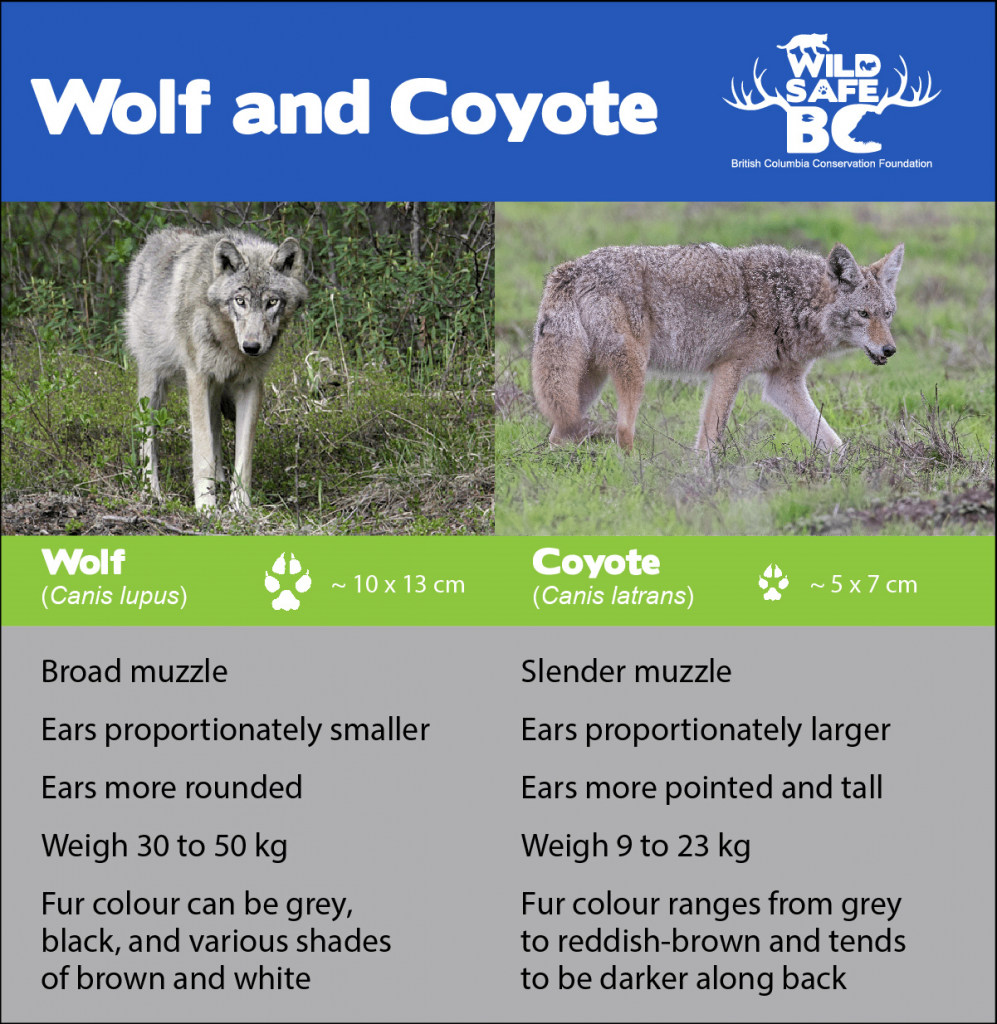
Wolves are larger than coyotes with wide broad paws, a broader snout and rounded ear tips. While running, wolves tend to carry their tails out behind them unlike coyotes that will carry their tails downwards. Despite its name, grey wolves can have a variety of coat colours including black, mottle grey, brown and white. The black coat color is a result from wolves interbreeding with dogs over 45,000 years ago.
Biology
Wolves are opportunistic carnivores that will also feed on carrion (dead animals). Wolves predate on moose, deer, caribou, elk as well as small mammals such as beavers, hares, and many small rodents. The wolves’ primary prey changes according to their region, for example some wolves have learned how to utilize salmon on coastal streams. When there is a surplus of food, wolves will bury these items as a cache much like cougars do. Wolves can weigh from 30 to 50 kg in BC with females being about 20% smaller.
In BC, breeding occurs around February to March. An average of 5 to 6 pups are born in the den after about 63 days of gestation, around April to May. The pups will remain inside the den for another two weeks and not venture far. Sometimes another wolf from the pack will watch over them while their parents hunt. By late fall they will begin to travel with the pack. By next breeding season, subadults (aka yearlings) may disperse great distances to find or establish new packs. Pups experience high mortality rates and adult wolves on average will only live to about five years of age in the wild. Starvation and fighting with other wolves are leading causes of natural mortality.
Wolves play an important role in the structure of predator-prey relationships. They often interact with predators like cougars and bears when competing for prey, and can influence prey populations, such as the number of deer or moose in an area.
Behaviour
Wolves are very social animals using a large repertoire of sounds, scents and body language to communicate with each other. Howling is used by wolf packs to communicate over long distances while lone wolves remain silent to protect themselves from detection.
Wolf packs are led by a dominant breeding male and female that will have one litter per year of four to six pups. Pack size usually consists of four to eight animals but can expand if the pack preys on larger prey sources such as moose and bison.
Wolves are very territorial animals and will defend against incursion by other wolves. This defensive nature often leads to fights amongst wolves and can cause high mortality rates. Wolves may also attack off-leash dogs as they often see them as competitors or as potential prey.
Range and Habitat
Wolves were once widely distributed throughout North America but were extirpated from much of their original range as a result of predation on livestock and competition with humans for wild prey. In BC, wolves have continued to persist and are found throughout British Columbia in a wide of habitats. Once extirpated from Vancouver Island as a result of hunting and persecution, they have now recolonized the Island.
Wolf Safety
Wolves tend to be elusive animals that avoid contact with humans, however their habitat and territories often overlap areas used by humans to live, work, recreate and raise livestock and grow food.
Avoid Wolf Encounters
- Become informed of areas where wolf sightings and encounters are occurring and take precautions.
- Be aware of your surroundings, do not wear earbuds to listen to music when in nature as this blocks one of your key senses.
- Make noise and let bears, cougars and wolves know you are in the area. Most wild animals want to avoid people.
- Carry bear spray in case you encounter a bear, cougar or wolf that may be a threat to your safety or that of your pet.
- Keep pets on a leash and do not let them approach or chase wildlife. Small pets should be kept close, even on a leash in wildlife country. Wolves are territorial and may view your pet as a potential threat or prey.
Wolf Encounters
- If you see a wolf, do not let it approach. Avoid the temptation to capture a photograph and do not let wolves become comfortable around people. Keeping them wild and wary is safer for everyone.
- If you encounter a wolf or wolves on a kill, they may become defensive or territorial. Slowly back out of the area without running or turning your back. Have your bear spray handy and ready to deploy.
- If a wolf approaches and shows signs of aggression, DO NOT RUN. Be assertive with the animal by throwing rocks, yelling, making yourself appear large and threatening. It is important that you NEVER play dead with a wolf. Keep slowly backing away and out of the area until you can get to safety.
- Use bear spray as a deterrent much as you would with a bear or cougar.
Wolf Attacks
Wolf attacks on people are very rare but if you are attacked and do not have bear spray, fight back and use whatever objects are at hand. Wolf attacks on dogs are more common, especially if they are off-leash or left unsupervised in an unfenced yard in wolf country.
When you are safe, be sure to call the Conservation Officer Service reporting line 1-877-952-7277 to report the incident. It is important that we report incidences like these as soon as possible to ensure the safety of others.
Conflict Reduction with Wolves
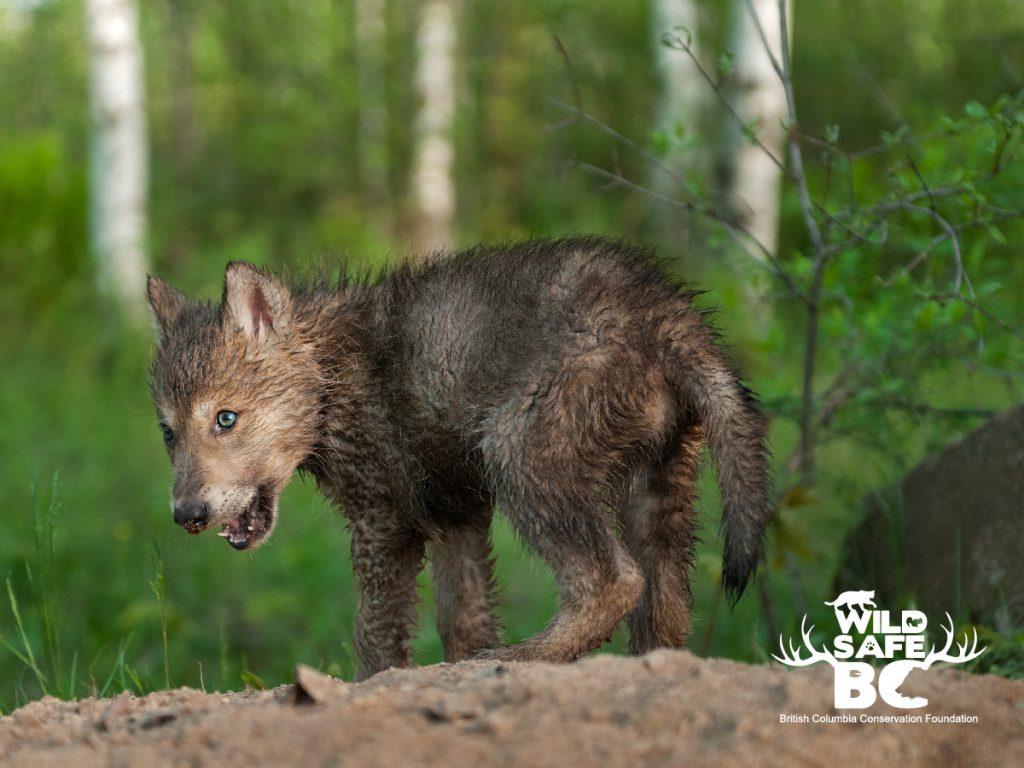
Unlike coyotes, wolves are more likely to avoid densely populated areas. However, wolves and their signs have been seen in many communities in BC where there is sufficient cover and travel corridors. Avoid wolf conflicts by following these best practices:
- Never try to feed a wolf either directly or indirectly.
- Keep your pets indoors, especially at night, to avoid attracting wolves and other predators. Keep your pet close and on a leash in areas with wolf and other predator activity.
- Feed your pets indoors. If your pets are fed outside, clean up all food afterwards and store bowls indoors. Store your pet food indoors or in a bear-resistant bin.
- To keep livestock, bees, and chickens safe, use a properly installed electric fence that is maintained regularly and should follow WildSafeBC’s electric fencing guidelines. Store your feed in a secure location. Ensure feeding areas are clean and free of attractants (feed attracts rodents which can in turn can attract wolves). For more information on protecting livestock, read WildSafeBC's tips on reducing conflict where we grow.
- If you have a bird feeder, clean up any accumulated seed under it which can also attract rodents. Remember to take feeders down when bears are active.
- NEVER feed deer or prey species as they can attract large predators such as wolves. Urban deer present their own set of problems for your neighbourhood.
Avoid Human Habituation
To spot an elusive wolf in the wild can be an exciting moment for those that appreciate wildlife. However, prolonging an interaction with a wolf, or trying to take a video or photo, can lead to human habituation. As wolves lose their natural wariness of humans, they may become too comfortable near humans which can lead to increased conflicts. We all share a responsibility to keep wolves wild.
Special Note for Kayakers and Campers
When recreating and camping in BC, always be sure to have a “bare campsite”. In some coastal BC parks, wolves have learned to open the hatches of sea kayaks. Always visit a park’s website before leaving home to check for wildlife alerts and recommendations on conflict reduction. Many parks do not allow dogs, on leash or otherwise, as a result of the potential conflict with wildlife.
Wolf Snapshot
The grey wolf (Canis lupus) is the largest of the North American canines which includes coyotes, foxes and domestic dogs. It is estimated that there are approximately 8,500 wolves in BC but this number can vary substantially year to year. Wolves are social animals closely related to coyotes and domestic dogs but with noticeable differences. Wolves are larger than coyotes with wide broad paws, a broader snout and rounded ear tips. While running, wolves tend to carry their tails out behind them unlike coyotes that will carry their tails downwards. Despite its name, grey wolves can have a variety of coat colours including black, mottle grey, brown and white. The black coat colour is a result from wolves interbreeding with dogs over 45,000 years ago.
Wolves are widely distributed throughout British Columbia. Once extirpated from Vancouver Island, they have returned and recolonized. Human-wolf conflicts occur when wolves prey on livestock or domestic pets. While attacks on people are exceedingly rare, food-conditioned and habituated wolves can be a concern to public safety and their pets. The Conservation Officer Service receives an average of 400 calls per year regarding wolves. If you encounter a wolf, avoid the temptation to stare or take a photo and instead, focus on scaring the animal away. Maintaining a wolf’s wariness of humans is the safest strategy for all.
Wild Wolf Facts
- The wolf (Canis lupus) is also known as the grey wolf, western wolf, and northern grey in BC.
- Wolves are marathon runners that can cover long distances and sprint up to 60 km/hr.
- Wolves are opportunistic carnivores that have even adapted to eating salmon in coastal areas.
- Wolves are larger than coyotes and have a broader snout and rounded ear tips. While running, wolves tend to carry their tails out behind them unlike coyotes that will carry their tails downwards.
- Wolves can have a variety of coat colours including black, mottle grey, brown and white. The black coat color is a result from wolves interbreeding with dogs over 45,000 years ago.
- Wolves can weigh from 30-50 kg in BC with females being about 20% smaller.
- Wolf packs, led by a dominant breeding male and female, will howl to communicate over long distances. Lone wolves remain silent to avoid detection.
- Wolves are short-lived animals managing only five years on average. Fights with other wolves and starvation are the leading causes of mortality.
- Historical wolf attacks by healthy wild wolves on humans are very rare in North America.
Identification

Wolves are larger than coyotes with wide broad paws, a broader snout and rounded ear tips. While running, wolves tend to carry their tails out behind them unlike coyotes that will carry their tails downwards. Despite its name, grey wolves can have a variety of coat colours including black, mottle grey, brown and white. The black coat color is a result from wolves interbreeding with dogs over 45,000 years ago.
Biology
Wolves are opportunistic carnivores that will also feed on carrion (dead animals). Wolves predate on moose, deer, caribou, elk as well as small mammals such as beavers, hares, and many small rodents. The wolves’ primary prey changes according to their region, for example some wolves have learned how to utilize salmon on coastal streams. When there is a surplus of food, wolves will bury these items as a cache much like cougars do. Wolves can weigh from 30 to 50 kg in BC with females being about 20% smaller.
In BC, breeding occurs around February to March. An average of 5 to 6 pups are born in the den after about 63 days of gestation, around April to May. The pups will remain inside the den for another two weeks and not venture far. Sometimes another wolf from the pack will watch over them while their parents hunt. By late fall they will begin to travel with the pack. By next breeding season, subadults (aka yearlings) may disperse great distances to find or establish new packs. Pups experience high mortality rates and adult wolves on average will only live to about five years of age in the wild. Starvation and fighting with other wolves are leading causes of natural mortality.
Wolves play an important role in the structure of predator-prey relationships. They often interact with predators like cougars and bears when competing for prey, and can influence prey populations, such as the number of deer or moose in an area.
Behaviour
Wolves are very social animals using a large repertoire of sounds, scents and body language to communicate with each other. Howling is used by wolf packs to communicate over long distances while lone wolves remain silent to protect themselves from detection.
Wolf packs are led by a dominant breeding male and female that will have one litter per year of four to six pups. Pack size usually consists of four to eight animals but can expand if the pack preys on larger prey sources such as moose and bison.
Wolves are very territorial animals and will defend against incursion by other wolves. This defensive nature often leads to fights amongst wolves and can cause high mortality rates. Wolves may also attack off-leash dogs as they often see them as competitors or as potential prey.
Range and Habitat
Wolves were once widely distributed throughout North America but were extirpated from much of their original range as a result of predation on livestock and competition with humans for wild prey. In BC, wolves have continued to persist and are found throughout British Columbia in a wide of habitats. Once extirpated from Vancouver Island as a result of hunting and persecution, they have now recolonized the Island.
Wolf Safety
Wolves tend to be elusive animals that avoid contact with humans, however their habitat and territories often overlap areas used by humans to live, work, recreate and raise livestock and grow food.
Avoid Wolf Encounters
- Become informed of areas where wolf sightings and encounters are occurring and take precautions.
- Be aware of your surroundings, do not wear earbuds to listen to music when in nature as this blocks one of your key senses.
- Make noise and let bears, cougars and wolves know you are in the area. Most wild animals want to avoid people.
- Carry bear spray in case you encounter a bear, cougar or wolf that may be a threat to your safety or that of your pet.
- Keep pets on a leash and do not let them approach or chase wildlife. Small pets should be kept close, even on a leash in wildlife country. Wolves are territorial and may view your pet as a potential threat or prey.
Wolf Encounters
- If you see a wolf, do not let it approach. Avoid the temptation to capture a photograph and do not let wolves become comfortable around people. Keeping them wild and wary is safer for everyone.
- If you encounter a wolf or wolves on a kill, they may become defensive or territorial. Slowly back out of the area without running or turning your back. Have your bear spray handy and ready to deploy.
- If a wolf approaches and shows signs of aggression, DO NOT RUN. Be assertive with the animal by throwing rocks, yelling, making yourself appear large and threatening. It is important that you NEVER play dead with a wolf. Keep slowly backing away and out of the area until you can get to safety.
- Use bear spray as a deterrent much as you would with a bear or cougar.
Wolf Attacks
Wolf attacks on people are very rare but if you are attacked and do not have bear spray, fight back and use whatever objects are at hand. Wolf attacks on dogs are more common, especially if they are off-leash or left unsupervised in an unfenced yard in wolf country.
When you are safe, be sure to call the Conservation Officer Service reporting line 1-877-952-7277 to report the incident. It is important that we report incidences like these as soon as possible to ensure the safety of others.
Conflict Reduction with Wolves

Unlike coyotes, wolves are more likely to avoid densely populated areas. However, wolves and their signs have been seen in many communities in BC where there is sufficient cover and travel corridors. Avoid wolf conflicts by following these best practices:
- Never try to feed a wolf either directly or indirectly.
- Keep your pets indoors, especially at night, to avoid attracting wolves and other predators. Keep your pet close and on a leash in areas with wolf and other predator activity.
- Feed your pets indoors. If your pets are fed outside, clean up all food afterwards and store bowls indoors. Store your pet food indoors or in a bear-resistant bin.
- To keep livestock, bees, and chickens safe, use a properly installed electric fence that is maintained regularly and should follow WildSafeBC’s electric fencing guidelines. Store your feed in a secure location. Ensure feeding areas are clean and free of attractants (feed attracts rodents which can in turn can attract wolves). For more information on protecting livestock, read WildSafeBC's tips on reducing conflict where we grow.
- If you have a bird feeder, clean up any accumulated seed under it which can also attract rodents. Remember to take feeders down when bears are active.
- NEVER feed deer or prey species as they can attract large predators such as wolves. Urban deer present their own set of problems for your neighbourhood.
Avoid Human Habituation
To spot an elusive wolf in the wild can be an exciting moment for those that appreciate wildlife. However, prolonging an interaction with a wolf, or trying to take a video or photo, can lead to human habituation. As wolves lose their natural wariness of humans, they may become too comfortable near humans which can lead to increased conflicts. We all share a responsibility to keep wolves wild.
Special Note for Kayakers and Campers
When recreating and camping in BC, always be sure to have a “bare campsite”. In some coastal BC parks, wolves have learned to open the hatches of sea kayaks. Always visit a park’s website before leaving home to check for wildlife alerts and recommendations on conflict reduction. Many parks do not allow dogs, on leash or otherwise, as a result of the potential conflict with wildlife.
